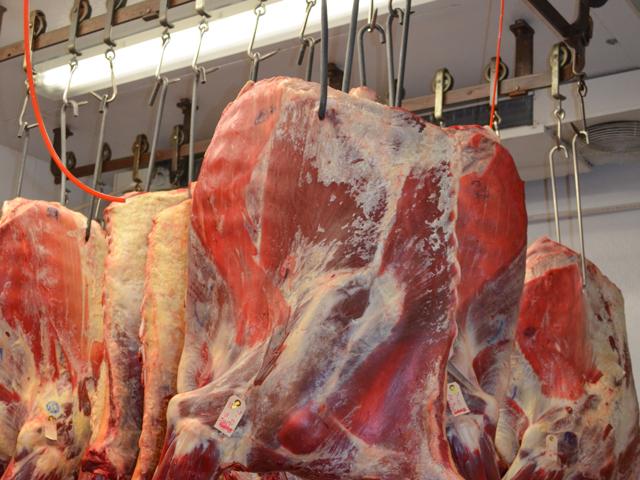USDA Receives Comments on Processing
Ideas to Expand Meat Processing With USDA Dollars
The public comment period has closed for USDA's plans to provide federal funds to expanding processing for beef, pork and poultry production nationally.
USDA first announced $500 million in funding for livestock and poultry processors back in July at an event in Iowa as President Joe Biden was signing his executive order on competition. The funds are expected to go towards grants, loans and technical assistance for smaller packers, processors and local meat lockers.
When the funds were announced, Agriculture Secretary Tom Vilsack said he saw the potential to match funds with private investment, as well as working with states and local economic-development officials to leverage the $500 million into potentially billions in investment.
With an Aug. 30 deadline for comments on its supply chain and competition plan, USDA received 460 comments through Regulations.gov. https://www.regulations.gov/….
The National Association of State Departments of Agriculture provided USDA with its comments on the funds. NASDA recommended flexible to help deal with workforce shortages and processing infrastructure for small to mid-sized facilities "is critical to ensuring our food system is built to handle future challenges." NASDA recommended funds for Cooperative Extension to offer training on meat inspection and sanitary standards. NASDA also recommended offsetting recruitment costs for employers and provide funds for apprenticeship programs. NASDA also called on USDA to reimburse processors for meat inspector overtime charges. NASDA also offered a detailed list of regional proposals as well. https://www.nasda.org/…
Several state secretaries of Agriculture sent in their own comments as well. Iowa Secretary of Agriculture Mike Naig suggested USDA consider redefining plant size to define "very small" and small processors. A very small processor has fewer than 10 employees while a small processor has a range from 10 to 500 workers. Naig recommended some categories for medium or mid-sized processors based on the number of employees. Naig also called on USDA not to exclude state-inspected facilities from grants. Iowa has 250 licensed facilities, of which 150 of them are under state inspection rules. https://iowaagriculture.gov/…
P[L1] D[0x0] M[300x250] OOP[F] ADUNIT[] T[]
The North American Meat Institute defended the industry and supply chain despite "some popular perspectives being espoused about supply chains" due to "black swan " events during the past two years.
"Before trying to 'fix' something it is prudent to look back and acknowledge the benefits that flow from the system as it exists," NAMI stated.
NAMI then added comments pushing back on complains about increased consolidation in the industry. In its comments, NAMI criticized adding processing capacity through federal subsidies, stating "simply for the sake of having added capacity for a notoriously cyclical cattle supply is short sighted and could distort more significant and longer-term private sector investments."
NAMI then went on to cite testimony from a Purdue University agricultural economist and a Rabobank analyst who had testified before Congress earlier this year.
Regarding labor, though, NAMI suggested USDA look at supporting research and investment in technologies that would reduce the reliance on labor.
Tyson Foods filed its own letter, citing that the company welcomes competition from other processors. Tyson recommended USDA consider ways to help drive more minority and underserved groups into farming through grant programs to overcome barriers to entry. Tyson also stated USDA should increase funding to states and tribes under the Child Care and Development Fund, citing that the pandemic showed the challenges that "gaps in childcare can cause for critical supply changes and meant and poultry processors of all sizes." There should not be any waiting period for families of essential workers to get childcare under those federal grant programs. Tyson also highlighted that USDA should ensure small processors are meeting requirements for food safety and biosecurity as well. USDA also should partner with universities to develop technology to help produce and process food as well. https://www.regulations.gov/…
The Center for Rural Affairs in Nebraska cited that many small-scale, federally inspected processors in Iowa and Nebraska were "severely disappointed" in the eligibility limits of a recent USDA Meat and Poultry Inspection Readiness Grant program, and the financial barriers involved. At a minimum, CRA recommended USDA should designate at least $250 million in funds for new infrastructure and expansion of a grant program for small and mid-sized processors. That should include $125 million for establishments with fewer than 10 workers, or less than $2.5 million in sales, the center proposed. https://www.regulations.gov/…
The American Farm Bureau Federation proposed: Grants to processors for modernizing or expanding an existing facility, including new building construction; grants to modernize processing or manufacturing equipment; grants for down payments on new buildings for packing facilities; and grants to cost-share for implementing federal or state inspections.
Now the clock begins to tick on just how USDA will start to disperse some of those funds.
Chris Clayton can be reached at Chris.Clayton@dtn.com
Follow him on Twitter @ChrisClaytonDTN
(c) Copyright 2021 DTN, LLC. All rights reserved.






